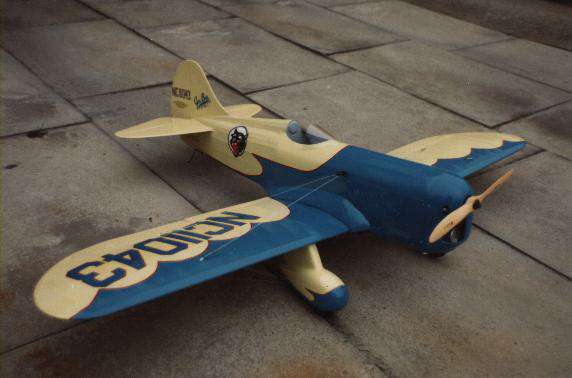Ivy and Martin's Web Page
|
The Gee Bee Model D Sportster is a 1/6 scale model of the 1930's sports and racing aeroplane. The structure is a traditional wooden framework with
fabric covering. It requires either a .40 2-stroke or .60 4-stroke engine and 4-channel radio. The wingspan is 56 inches and the weight should be between 4 and 7 lb.
The plans as supplied show the entire model structure in detail, with sufficient instructions. The quality of materials supplied is excellent, with accurate cutting of the plywood components. Vacuum-formed plastic parts are included for the front of the engine cowling and wheel covers. A high quality sheet of waterslide transfers is supplied.

Structure The fuselage sides are sheet balsa, with balsa stringers attached to the outside aft of the cockpit. The forward fuselage is completed by a curved balsa sheet top decking, with block balsa under the nose. At the rear stringers supported by sub-formers are used, the rear fuselage being fabric-covered. The engine is radially mounted inverted on a 1/4 inch ply former.
The wings are made in two halves which are then permanently joined. Assembly is straightforward with the ribs being threaded onto two spruce spars, after which a balsa sheet trailing edge and strip leading edge are added.
The ailerons are built with half-ribs on a balsa sheet core. Hardwood blocks are fitted to take the undercarriage legs, which are completely rigid. The central portion of the wing has balsa sheet covering with the rest being fabric covered.
The tailplane, elevators, fin and rudder are 1/4 inch thick flat sheet balsa, all permanently attached to the fuselage. Sheeted areas are finished with sanding sealer and tissue, with doped nylon covering used on the open-structure areas. More modern heat-shrink covering materials may be used instead. There is adequate space for the radio installation in the fuselage, leaving room for a fully open cockpit. The rudder and elevator are driven by pushrods or plastic snake tubes. The aileron servo is mounted in the centre of the wing, driving the ailerons via pushrods and bellcranks or curved plastic snake tubes. External rigging is provided in the form of silvered elastic cord which is threaded from the upper fuselage, through hard points in the outer wings to the wheel covers. The rigging is just for show and the model may be safely flown without it. Flying the model This model handles very much like any small sports/aerobatic model. It is quite fast, moderately stable and capable of all the usual manoevres. The glide is good, particularly if you dispense with the rigging wires. The wheels are further forward of the centre of gravity than usual, so there is no problem with it nosing over. Mine has never shown any tendency to ground-loop at all. Take-off requires some rudder correction to keep it straight, and the climb is brisk. Landings are easy, but the lack of springing means that you need to be careful not to bump it too hard. Structural assessment This model follows common practice for many small models with it's built-up wing, all sheet tail and sheet-balsa-based fuselage. The fuselage is a little over-engineered as the sides forward of the cockpit are 3/8 inch thick balsa (1/8 and 1/4 inch sheet laminated together). The balsa sheet sides aft of the cockpit represent a little excess weight too. Ideally the basic fuselage would be built up from balsa strip instead, but this has presumably not been done in order to simplify the structure and make it quicker to build. The undercarriage could do with some redesign to allow some form of shock absorption, as all the landing shocks are transmitted directly into the wing structure. How scale is it? The outline follows pretty closely the available scale drawings in all respects but one. The nose in plan view should be tapered in towards the front while the model has parallel sides. It is possible that this has been changed on later versions of the kit, as I once had to order a replacement plastic nose cowl and the one I got wouldn't fit, being considerably narrower, thus suiting a tapered nose. The tail surfaces let the appearance down, being thin and flat, but it would be a simple matter to scratchbuild replacements with a thicker, fabric-covered structure. The replacement of the elastic rigging cord with proper wire bracing would improve the appearance tremendously. There is plenty of scope for detailing the model, the most obvious additions being the louvred cowling side panels, exhaust pipes, external fuel gauge and filler cap. There is room for a detailed cockpit too. Reference to photographs will provide the information you need. Colour schemes This is easy: There was only the one and it's colours are well documented. The transfer sheet covers all the markings accurately, making an easy job of decorating it. For those who want a different appearance, there were a few similar aircraft built in alternative colours, but there were detail differences, usually in the tailfin size and shape and undercarriage design. Final verdict This is a quick to build model and looks very good in the eyecatching Gee Bee scalloped colour scheme. It is an excellent flyer with no bad characteristics at all. |
| The Gee Bee kit is now manufactured by Brodak. There have been changes to the kit presentation since this review was written. |
Have your say! Do you have any comments, observations, experience you would like to add? Do you agree with the above, or disagree?
All valid contributions will be added to the review, credited to you. Simply fill in the form below and click the "send form" button.
None of your personal information will be passed to anybody else for any purpose whatsoever.
| Back to Kit Review Index | Main Index | Martin's Photography on Picfair | Our stuff on Redbubble | Email Martin |